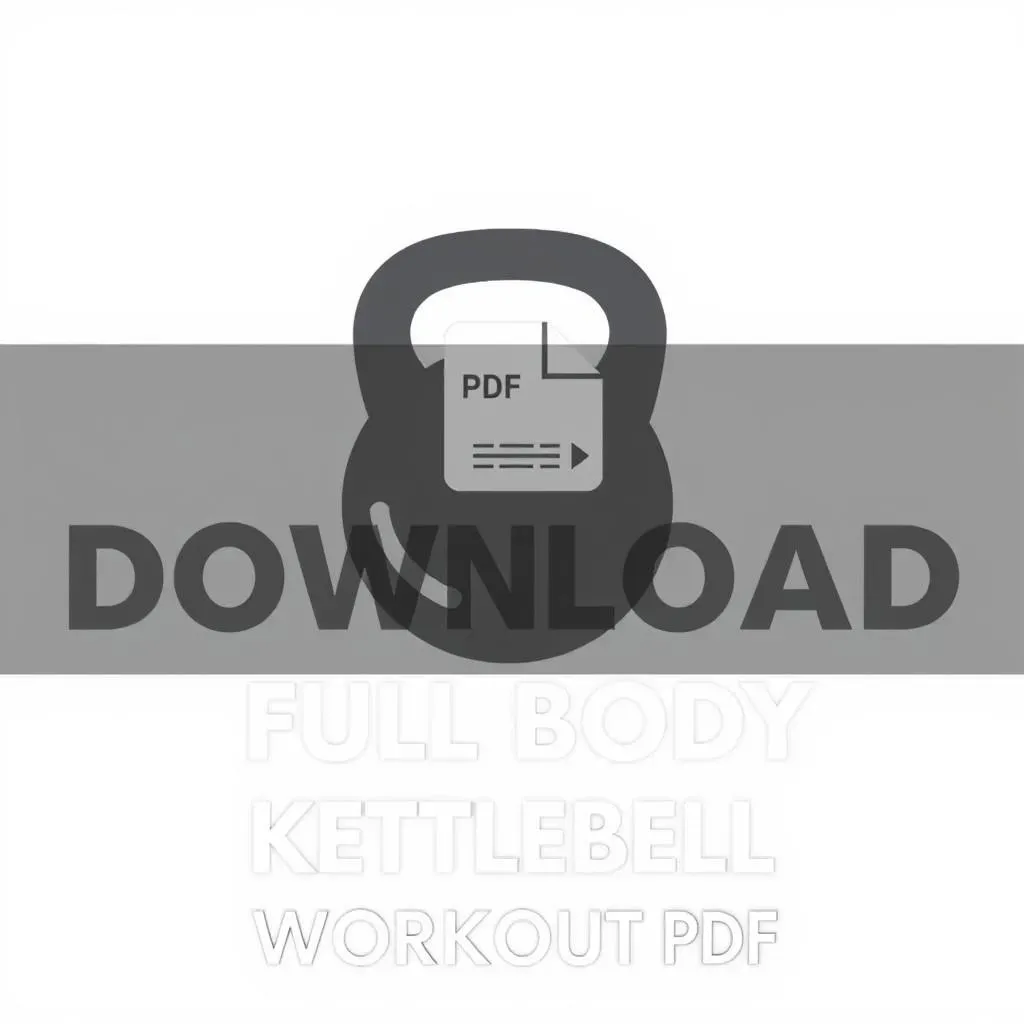Table of Contents
Ready to torch calories, build serious muscle, and feel like a total badass? Then you've come to the right place. Kettlebells are the ultimate tool for a full body transformation, offering a dynamic and effective way to train. Forget endless hours on the treadmill or mind-numbing bicep curls. We're diving headfirst into the world of kettlebell training, and we're doing it with a plan you can take anywhere. This article is your gateway to understanding the power of kettlebell workouts. We'll break down essential exercises, guide you in creating your own personalized routines, and, best of all, provide a link for a full body kettlebell workout PDF free download. Whether you're a seasoned athlete or just starting your fitness journey, get ready to unlock your potential. We'll cover proper form, technique tweaks, and even advanced training tips to keep you challenged and progressing. So, grab your kettlebell (or get ready to order one!), and let's get started!
Master the Kettlebell: Essential Full Body Exercises

Master the Kettlebell: Essential Full Body Exercises
Kettlebell Swing: The Foundation
Let's kick things off with the kettlebell swing. Seriously, if you only learn one kettlebell exercise, make it this one. It's the cornerstone of so many other movements and a powerhouse for your posterior chain – think glutes, hamstrings, and back. You're not just lifting the kettlebell; you're generating power from your hips, like you're trying to launch it into orbit.
Think of it as a deadlift, but with a dynamic hip hinge. Keep your back straight, engage your core, and let that bell swing! Don't be afraid to start light and focus on the form. Trust me, a perfect swing with a lighter weight is way more effective than a sloppy swing with something heavy. You will feel it in your lower back if you do not do it correctly.
Goblet Squat: Core and Quads on Fire
Next up, the goblet squat. Hold the kettlebell close to your chest, like you're cradling a baby (a heavy, iron baby). This position forces you to engage your core and maintain an upright posture. As you squat down, focus on pushing your knees out and keeping your chest up. Go as low as you comfortably can while maintaining good form.
The goblet squat is fantastic because it improves your squat mechanics, strengthens your quads, and challenges your core stability. It is also a great way to learn how to squat properly if you are new to squatting. Don't be surprised if you feel this one in your abs the next day! Also, you can use a dumbbell if you do not have access to a kettlebell, or you can use no weight at all.
Exercise | Muscles Targeted | Benefits |
|---|---|---|
Kettlebell Swing | Glutes, Hamstrings, Back | Power, Endurance, Core Stability |
Goblet Squat | Quads, Core, Glutes | Squat Mechanics, Strength, Stability |
Kettlebell Turkish Get-Up: The Ultimate Challenge
Alright, this one's a bit of a beast, but trust me, it's worth it. The Turkish Get-Up (TGU) is a full-body exercise that improves mobility, stability, and strength. It involves a series of controlled movements to go from lying on the ground to standing up while holding a kettlebell overhead.
It sounds complicated, and it is at first, but break it down into smaller steps and practice each one. Start with no weight, then progress to a light kettlebell. The TGU not only builds strength and coordination, but also teaches you how to move your body efficiently and safely. This exercise is a great way to improve your overall fitness and athleticism.
Craft Your Own Full Body Kettlebell Workout Routine

Craft Your Own Full Body Kettlebell Workout Routine
Set Your Goals: What Do You Want to Achieve?
Before you even pick up a kettlebell, take a minute to think about what you want to get out of your workouts. Are you trying to build strength, lose weight, improve your endurance, or just feel better overall? Your goals will dictate the types of exercises you choose, the number of reps and sets you perform, and the frequency of your workouts. Be specific! Instead of "lose weight," aim for "lose 10 pounds in 8 weeks." Instead of "get stronger," aim for "increase my kettlebell swing weight by 25%."
Once you've defined your goals, write them down. This will help you stay motivated and track your progress. It's also a good idea to take before-and-after photos or measurements to see how far you've come. Remember, consistency is key. Even small, incremental improvements can add up to big results over time. Don't get discouraged if you don't see progress immediately. Just keep showing up and putting in the work, and you will get there.
Choose Your Exercises: Compound Movements are King
Now comes the fun part: selecting your exercises. For a full body kettlebell workout, focus on compound movements that work multiple muscle groups at once. Think swings, squats, lunges, presses, and rows. These exercises are not only more effective at building strength and burning calories, but they also improve your coordination and balance.
When choosing exercises, consider your current fitness level and any injuries or limitations you may have. Start with basic movements and gradually progress to more challenging variations as you get stronger. Don't be afraid to modify exercises to fit your needs. For example, if you have trouble with regular squats, try box squats or goblet squats. The most important thing is to listen to your body and avoid pushing yourself too hard, too soon.
Exercise Category | Example Exercises | Benefits |
|---|---|---|
Lower Body | Kettlebell Swings, Goblet Squats, Lunges | Strength, Power, Endurance |
Upper Body | Kettlebell Presses, Rows, Turkish Get-Ups | Strength, Stability, Mobility |
Core | Kettlebell Russian Twists, Plank Drags | Stability, Rotation, Anti-Extension |
Structure Your Workout: Sets, Reps, and Rest
Once you've chosen your exercises, it's time to structure your workout. Decide how many sets and reps you'll perform for each exercise, and how much rest you'll take between sets. There's no one-size-fits-all approach, so experiment to find what works best for you. As a general guideline, aim for 3-4 sets of 8-12 reps for strength building, or 2-3 sets of 15-20 reps for endurance. Adjust the weight accordingly.
Rest is just as important as the exercises themselves. It allows your muscles to recover and rebuild, which is essential for growth. The amount of rest you need will depend on the intensity of your workout and your fitness level. Start with 60-90 seconds of rest between sets and adjust as needed. Remember to listen to your body and don't be afraid to take extra rest if you need it. Also, do not forget to properly warm up before your workout and cool down afterward.
Free Download: Your Printable Full Body Kettlebell Workout PDF

Free Download: Your Printable Full Body Kettlebell Workout PDF
Alright, you've got the knowledge, you've got the plan, now it's time to put it into action! To make things even easier, I've created a free download: your printable full body kettlebell workout PDF. This PDF includes a sample workout routine that you can follow, complete with exercise descriptions, sets, reps, and rest periods. It's perfect for beginners who are just starting out, or for experienced kettlebell enthusiasts who are looking for new ideas. This is designed to be super accessible, whether you are at home, in the gym, or even traveling. No excuses!
The PDF is structured to be easy to follow. Each exercise has a brief description and a link to a video demonstration. It's designed to be printed out and taken with you to the gym or used at home. I've included variations for different fitness levels, so you can customize the workout to fit your needs. Remember to listen to your body and adjust the workout as needed. And most importantly, have fun! This workout is designed to be challenging, but also rewarding. So, download the PDF, grab your kettlebell, and let's get started!
Maximize Results: Kettlebell Workout Tips and Techniques

Maximize Results: Kettlebell Workout Tips and Techniques
Perfect Your Form: Quality Over Quantity
listen up! This is where a lot of people go wrong. They get all gung-ho and start throwing around the kettlebell without a second thought about their form. That's a recipe for injury and a surefire way to stall your progress. It's way better to slow down, focus on perfecting your technique, and gradually increase the weight as you get stronger. Think of it like learning a musical instrument – you wouldn't start with a complex concerto, would you? You'd start with the basics and gradually build your skills. Same goes for kettlebells. Master the fundamentals, and the rest will follow.
Film yourself! Seriously, set up your phone or camera and record yourself performing the exercises. Then, watch the footage and compare your form to videos of expert kettlebell instructors. You'll be surprised at how much you can learn from watching yourself. Pay attention to your posture, your movement patterns, and your overall body mechanics. Are you keeping your back straight during swings? Are your knees tracking over your toes during squats? Are you maintaining a stable core throughout the exercises? Identify any areas where you can improve, and then focus on correcting them during your next workout.
Progressive Overload: Challenge Yourself Consistently
Alright, so you've mastered the form, now what? Well, you can't just keep doing the same workout with the same weight forever and expect to see results. Your body is incredibly adaptable, and it will quickly get used to the demands you're placing on it. That's where progressive overload comes in. It's the principle of gradually increasing the stress you're placing on your muscles over time. This forces your body to adapt and get stronger.
There are several ways to implement progressive overload with kettlebells. You can increase the weight you're lifting, add more reps or sets, decrease your rest periods, or try more challenging variations of the exercises. For example, if you're currently doing 3 sets of 10 kettlebell swings with a 16kg kettlebell, you could try increasing the weight to 20kg, adding a fourth set, increasing the reps to 12, or decreasing your rest periods from 60 seconds to 45 seconds. The key is to consistently challenge yourself and push your limits.
Overload Method | Example | Benefits |
|---|---|---|
Increase Weight | Go from 16kg to 20kg kettlebell | Strength, Power |
Increase Reps/Sets | Add a set or more reps per set | Endurance, Muscle Growth |
Decrease Rest | Reduce rest time between sets | Cardiovascular Fitness, Intensity |
Listen to Your Body: Rest and Recovery are Key
This one's super important, and it's something that a lot of people neglect. You can't just go balls-to-the-wall every single workout and expect your body to hold up. You need to give it time to rest and recover. Overtraining can lead to injuries, burnout, and stalled progress. So, learn to listen to your body and recognize the signs of fatigue. Are you feeling unusually sore? Are your workouts feeling harder than usual? Are you having trouble sleeping? These are all signs that you need to dial it back and give your body some TLC.
Make sure you're getting enough sleep, eating a healthy diet, and staying hydrated. Consider incorporating active recovery days into your routine, such as light cardio, stretching, or foam rolling. And don't be afraid to take a complete rest day when you need it. Remember, rest and recovery are just as important as the workouts themselves. They're the fuel that allows you to keep pushing forward and achieving your goals. So, treat your body with respect, and it will reward you with strength, endurance, and a whole lot of awesomeness.
Beyond the Basics: Advanced Kettlebell Full Body Training

Beyond the Basics: Advanced Kettlebell Full Body Training
So, you've nailed the swings, conquered the squats, and maybe even attempted a Turkish Get-Up or two. You're feeling stronger, fitter, and more confident than ever. But now what? It's time to take your kettlebell training to the next level with some advanced techniques and exercises. We're talking about movements that will challenge your strength, coordination, and mental toughness. These aren't for the faint of heart, but if you're ready to push your limits and unlock your full potential, then let's dive in!
Think about it: you've built a solid foundation. Now, it's time to construct a skyscraper. We're going to explore complex combinations, unconventional exercises, and advanced programming strategies that will keep your body guessing and your muscles growing. Get ready to step outside your comfort zone and discover the true power of kettlebell training. This is where the real magic happens, where you transform from a casual enthusiast into a kettlebell ninja!
Complexes: Flowing Movements for Maximum Burn
Complexes are sequences of exercises performed back-to-back without putting the kettlebell down. They're a fantastic way to build strength, endurance, and coordination, all while torching a ton of calories. The key is to choose exercises that flow smoothly from one to the next, creating a seamless and challenging routine. For example, you could try a complex consisting of a kettlebell swing, a goblet squat, a push press, and a row. Perform all the reps for one exercise before moving on to the next, and try to complete the entire complex without setting the kettlebell down.
Start with lighter weights and focus on maintaining good form throughout the complex. As you get stronger, you can increase the weight or add more exercises to the sequence. Complexes are not only physically demanding, but they also require a lot of mental focus. You need to remember the sequence of exercises and maintain your concentration throughout the set. This makes them a great way to improve your mental toughness and resilience. Do not be afraid to start slow and build up gradually. The goal is to challenge yourself, not to injure yourself.
Complex Component | Description | Benefits |
|---|---|---|
Exercise Selection | Choose exercises that flow well together | Seamless Transitions, Full Body Engagement |
Weight Selection | Start light and gradually increase | Maintain Form, Prevent Injury |
Mental Focus | Remember the sequence and stay present | Improved Concentration, Resilience |
Unconventional Exercises: Get Creative with Your Training
Once you've mastered the basic kettlebell movements, it's time to get creative and explore some unconventional exercises. These are movements that you might not see in a typical gym, but they can be incredibly effective at building strength, mobility, and athleticism. Think about exercises like kettlebell juggling, windmills, and renegade rows. These movements challenge your body in new and unique ways, forcing you to adapt and get stronger.
Be sure to learn the proper technique before attempting these exercises. Start with lighter weights and gradually increase the weight as you get more comfortable. Unconventional exercises are not only physically challenging, but they're also a lot of fun! They can help you break out of your routine and rediscover your love of movement. Just remember to prioritize safety and listen to your body. If something doesn't feel right, stop and reassess your form. There's no shame in modifying an exercise to fit your needs. The most important thing is to stay safe and have fun!
Your Kettlebell Journey Starts Now
You've now got the knowledge and the tools – including that full body kettlebell workout PDF free download – to revolutionize your fitness routine. Remember, consistency and proper form are key. Don't be afraid to start slow, master the basics, and gradually increase the intensity. The power to transform your body and your fitness is literally in your hands. So, download the PDF, get swinging, and unleash the beast within!